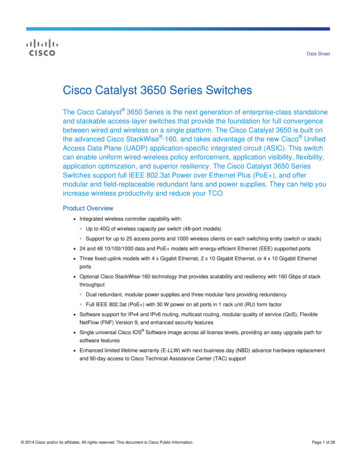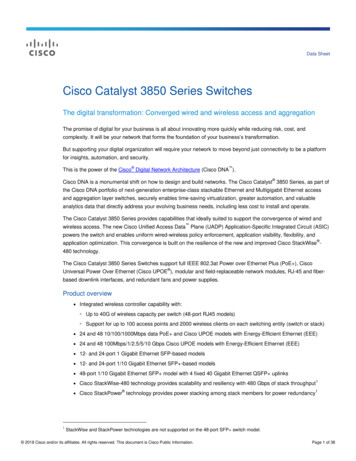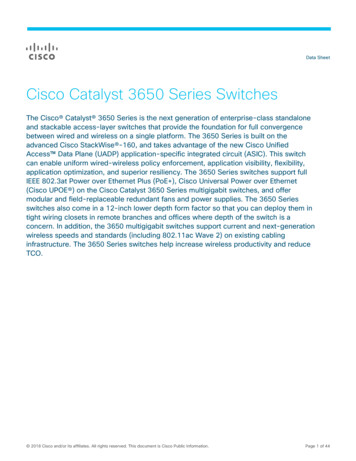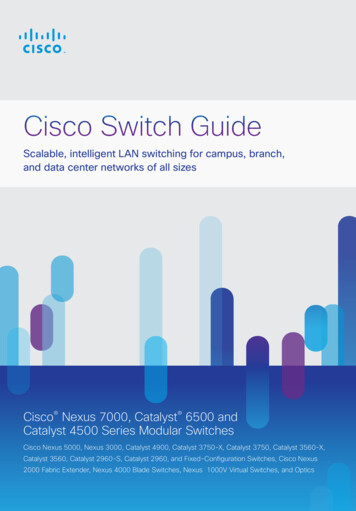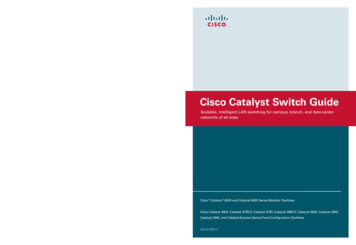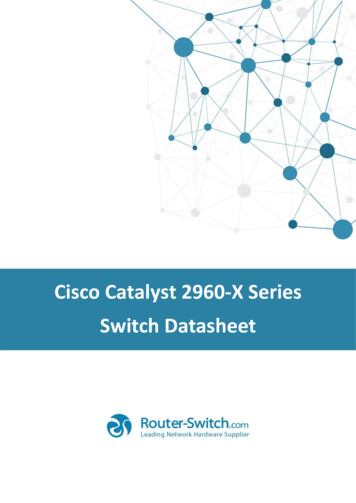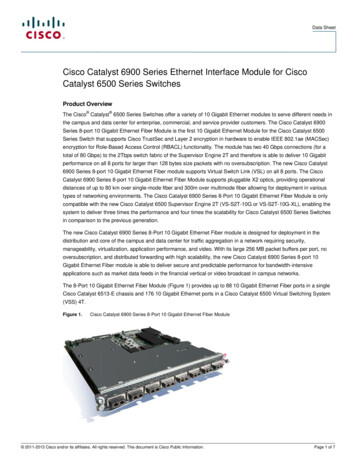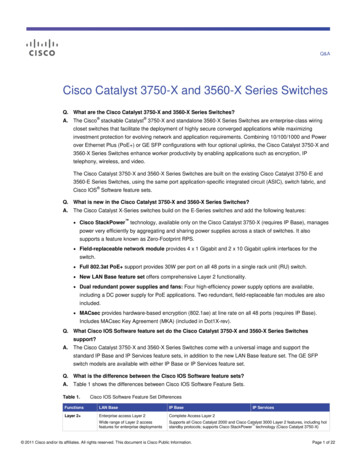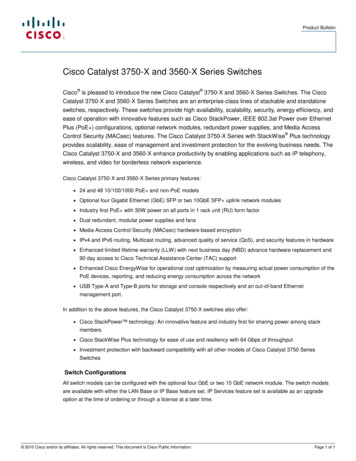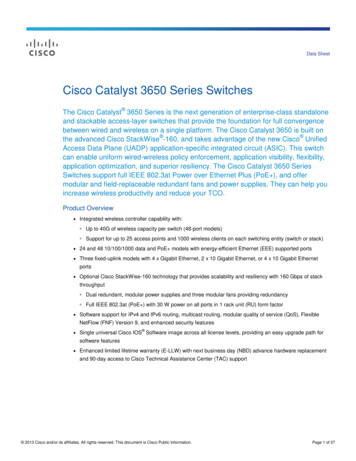
Transcription
Data SheetCisco Catalyst 3650 Series SwitchesThe Cisco Catalyst 3650 Series is the next generation of enterprise-class standaloneand stackable access-layer switches that provide the foundation for full convergencebetween wired and wireless on a single platform. The Cisco Catalyst 3650 is built onthe advanced Cisco StackWise -160, and takes advantage of the new Cisco UnifiedAccess Data Plane (UADP) application-specific integrated circuit (ASIC). This switchcan enable uniform wired-wireless policy enforcement, application visibility, flexibility,application optimization, and superior resiliency. The Cisco Catalyst 3650 SeriesSwitches support full IEEE 802.3at Power over Ethernet Plus (PoE ), and offermodular and field-replaceable redundant fans and power supplies. They can help youincrease wireless productivity and reduce your TCO.Product Overview Integrated wireless controller capability with: Up to 40G of wireless capacity per switch (48-port models) Support for up to 25 access points and 1000 wireless clients on each switching entity (switch or stack) 24 and 48 10/100/1000 data and PoE models with energy-efficient Ethernet (EEE) supported ports Three fixed-uplink models with 4 x Gigabit Ethernet, 2 x 10 Gigabit Ethernet, or 4 x 10 Gigabit Ethernetports Optional Cisco StackWise-160 technology that provides scalability and resiliency with 160 Gbps of stackthroughput Dual redundant, modular power supplies and three modular fans providing redundancy Full IEEE 802.3at (PoE ) with 30 W power on all ports in 1 rack unit (RU) form factorSoftware support for IPv4 and IPv6 routing, multicast routing, modular quality of service (QoS), FlexibleNetFlow (FNF) Version 9, and enhanced security features Single universal Cisco IOS Software image across all license levels, providing an easy upgrade path forsoftware features Enhanced limited lifetime warranty (E-LLW) with next business day (NBD) advance hardware replacementand 90-day access to Cisco Technical Assistance Center (TAC) support 2013 Cisco and/or its affiliates. All rights reserved. This document is Cisco Public Information.Page 1 of 27
Switch Models and ConfigurationsAll Cisco Catalyst 3650 Series Switches have fixed, built-in uplink ports and ship with one power supply. Tables 1through 5 provide further details. Figure 1 is an image of the Cisco Catalyst 3650 Series Switches.Figure 1.Cisco Catalyst 3650 Series SwitchesTable 1 shows the Cisco Catalyst 3650 Series configurations.Table 1.Cisco Catalyst 3650 Series ConfigurationsModelsFixed UplinksTotal 10/100/1000Ethernet PortsDefault AC Power SupplyAvailable PoE PowerWS-C3650-24TS4 x Gigabit Ethernet withSmall Form-FactorPluggable (SFP)24250 WAC-640 WAC390 W1025 WAC775 WWS-C3650-48TS48WS-C3650-24PS24 PoE WS-C3650-48PS48 PoE WS-C3650-48FS48 PoE WS-C3650-24TDWS-C3650-48TD2 x 10 Gigabit Ethernet with 24SFP or 4 x Gigabit48Ethernet with SFPWS-C3650-24PD24 PoE WS-C3650-48PD48 PoE WS-C3650-48FD48 PoE WS-C3650-48TQWS-C3650-48PQ4 x 10 Gigabit Ethernet with 48SFP or 4 x Gigabit48 PoE Ethernet with SFPWS-C3650-48FQ48 PoE 250 WAC640 WAC390 W1025 WAC775 W250 WAC640 WAC390 W1025 WAC775 WFixed UplinksAll Cisco Catalyst 3650 Series Switches have fixed, built-in uplink ports. Customers can choose from three typesof uplink ports at the time of the switch purchase: 4 x Gigabit Ethernet with Small Form-Factor Pluggable (SFP) 2 x 10 Gigabit Ethernet with SFP or 4 x Gigabit Ethernet with SFP 4 x 10 Gigabit Ethernet with SFP or 4 x Gigabit Ethernet with SFPThe SFP interface supports both 10 Gigabit Ethernet and Gigabit Ethernet ports. Refer to Table 1 for adescription of the basic switch models and the corresponding uplink ports. Refer to Table 2 for a description of thevarious uplink port interface options. 2013 Cisco and/or its affiliates. All rights reserved. This document is Cisco Public Information.Page 2 of 27
Table 2.Network Module ConfigurationsInterface OptionsNetwork Module10 Gigabit Ethernet SFP PortsGigabit Ethernet SFP Ports4 x Gigabit Ethernet044 x Gigabit Ethernet/2 x10 Gigabit EthernetNetwork Modules20041240042231134 x Gigabit Ethernet/4 x10 Gigabit EthernetNetwork ModulesDual Redundant Modular Power SuppliesThe Cisco Catalyst 3650 Series Switches support dual redundant power supplies (See Figure 2). The switch shipswith one power supply by default, and the second power supply can be purchased at the time of ordering theswitch or at a later time. If only one power supply is installed, it should always be in power supply bay 1. Theswitch also ships with three field-replaceable fans.Figure 2.Redundant Power SuppliesTable 3 shows the different power supplies available in these switches and available PoE power.Table 3.Switch Models and Corresponding Default Power SuppliesModelsDefault Power SupplyAvailable PoE Power24-port data switchPWR-C2-250WAC-PWR-C2-640WAC390 WPWR-C2-1025WAC775 W48-port data switch24-port PoE switch48-port PoE switch48-port full PoE switchIn addition to the power supplies listed in Table 3, a 640 WDC power supply is available at the time of order or asa spare on all switch models. The DC power supply also delivers PoE capabilities for maximum flexibility (refer toTable 5 for available PoE budget with DC power supplies). Customers can mix and match the AC and DC powersupplies in the two available power supply slots. Any of these power supplies can be installed in any of theswitches.11The 250 WAC power supply will be supported on the PoE-capable switches in a future release. 2013 Cisco and/or its affiliates. All rights reserved. This document is Cisco Public Information.Page 3 of 27
Table 4.Available PoE with DC Power SupplyModelNumber of 440WDC Power SuppliesTotal Available PoE Budget24-port or 48-port PoE Switch1390 W2780 WPower over Ethernet Plus (PoE )The Cisco Catalyst 3650 Series Switches support both PoE (IEEE 802.3af) and PoE (IEEE 802.3at standard),which provide up to 30 W of power per port. PoE removes the need for wall power to each PoE-enabled deviceand eliminates the cost for additional electrical cabling and circuits that would otherwise be necessary in IP phoneand WLAN deployments. The Cisco Catalyst 3650 Series Switches can provide a lower TCO for deployments that incorporate Cisco IP phones, Cisco Aironet wireless LAN (WLAN) access points, or any IEEE 802.3at-compliantend device. Table 5 shows the power supply combinations required for different PoE needs.Table 5.Minimum Power Supply Requirements for Full PoE and PoE 24-Port PoE Switch48-Port PoE SwitchPoE on All Ports (15.4 W per port)One PWR-C2-640 WACOne PWR-C2-1025WAC or Two PWR-C2-640WACPoE on All Ports (30 W per port)One PWR-C2-1025WAC or Two PWR-C2-640WACTwo PWR-C2-1025 WACBenefitsConverged Wired plus Wireless AccessThe Cisco Catalyst 3650 is a standalone and stackable access switching platform that enables wired plus wirelessservices on a single Cisco IOS XE Software-based platform. With this, Cisco has pioneered a host of richcapabilities such as high availability based on stateful switchover (SSO) on stacking, granular QoS, security, andFlexible Netflow (FNF) across wired and wireless in a seamless fashion. Also, the wired plus wireless features arebundled into a single Cisco IOS Software image, which reduces the number of software images that users have toqualify/certify before enabling them in their network. The single console port for command-line interface (CLI)management reduces the number of touch points to manage for wired plus wireless services, thereby reducingnetwork complexity, simplifying network operations, and lowering the TCO to manage the infrastructure.Converged wired plus wireless not only improves wireless bandwidth across the network but also the scale ofwireless deployment. Each 48-port Cisco Catalyst 3650 provides 40 Gbps of wireless throughput (20 Gbps on the24-port model). This wireless capacity increases with the number of members in the stack. This makes sure thatthe network can scale with current wireless bandwidth requirements, as dictated by IEEE 802.11n-based accesspoints and with future wireless standards such as IEEE 802.11ac. Additionally, the Cisco Catalyst 3650 distributesthe wireless controller functions to achieve better scalability. Each Cisco Catalyst 3650 switch/stack can operateas the wireless controller in two modes: Mobility agent (MA): This is the default mode in which the Cisco Catalyst 3650 switch ships. In this modethe switch is capable of terminating the CAPWAP tunnels from the access points and providing wirelessconnectivity to wireless clients. Maintaining wireless client databases and configuring and enforcingsecurity and QoS policies for wireless clients and access points can be enforced in this mode. Noadditional license on top of IP Base is required to operate in the mobility agent mode. 2013 Cisco and/or its affiliates. All rights reserved. This document is Cisco Public Information.Page 4 of 27
Mobility controller (MC): In this mode, the Cisco Catalyst 3650 switch can perform all the mobility agenttasks in addition to mobility coordination, radio resource management (RRM), and Cisco CleanAir coordination within a mobility subdomain. The mobility controller mode can be enabled on the switch CLI.IP Base license level is required when the Cisco Catalyst 3650 switch is acting as the mobility controller.A centrally located Cisco 5508 Wireless LAN Controller (WLC 5508), Cisco Wireless Services Module 2(WiSM2) (when running AireOS Version 7.3), and Wireless LAN Controller 5760 can also perform this rolefor larger deployments.With mobility agents located in the wiring closets providing 40 Gbps of wireless per switch (n x 40 Gbps fora stack of n switches) and mobility controllers managing some of the central wireless functions, theconverged access-based wireless deployment provides best-in-class scalability for wireless andsignificantly improved wireless throughput.Figure 3.Mobility Controller (MC) and Mobility Agent (MA) 2013 Cisco and/or its affiliates. All rights reserved. This document is Cisco Public Information.Page 5 of 27
Distributed Intelligent ServicesFlexible NetFlow (FNF)Full visibility into the wired plus wireless traffic is achieved because of the access point Control and Provisioning ofWireless Access Points (CAPWAP) tunnel termination on the switch. This helps identify users and user trafficflows in order to identify potential attackers and take corrective action at the access layer before the attackpenetrates further into the network. This is achieved using FNF, which monitors every single flow entering andexiting the switch stack for wired and wireless users. It also helps identify the top wired/wireless talkers andenforce appropriate bandwidth provisioning policies.QoSThe 3650 switch has advanced wired plus wireless QoS capabilities. It uses the Cisco modular QoS command lineinterface (MQC). The switch manages wireless bandwidth using unprecedented hierarchical bandwidthmanagement starting at the per-access-point level and drilling further down to per-radio, per-service setidentification (SSID), and per-user levels. This helps manage and prioritize available bandwidth between variousradios and various SSIDs (enterprise, guest, and so on) within each radio on a percentage basis. The switch isalso capable of automatically allocating equal bandwidth among the connected users within a given SSID. Thismakes sure that all users within a given SSID get a fair share of the available bandwidth while being connected tothe network. The UADP ASIC enables the hierarchical bandwidth management and fair sharing of bandwidth,thereby providing hardware-based QoS for optimized performance at line-rate traffic.In addition to these capabilities, the switch is able to do class of service (CoS) or differentiated services code point(DSCP) based queuing, policing, shaping, and marking of wired plus wireless traffic. This enables users to createcommon policies that can be used across wired plus wireless traffic. The 3650 also supports downloadable policynames from the Cisco Identity Services Engine (ISE) when a user successfully authenticates to the network usingthe ISE.SecurityThe Cisco Catalyst 3650 provides a rich set of security features for wired plus wireless users. Features such asIEEE 802.1x, Dynamic Host Configuration Protocol (DHCP) snooping, IP Source Guard and control planeprotection, wireless intrusion prevention systems (WIPSs), and so on enable protection against unauthorizedusers and attackers. With a variety of wired plus wireless users connecting to the network, the switch supportssession-aware networking, in which each device connected to the network is identified as one session, and uniqueaccess control lists (ACLs) and/or QoS policies can be defined and applied using the ISE for each of thesesessions, providing better control on the devices connecting to the network.ResiliencyCisco StackWise-160 TechnologyThe Catalyst 3650 supports an optional stacking module that is based on the Cisco StackWise-160 technology. Cisco StackWise-160 technology is built on the highly successful industry-leading StackWise technology, whichis a premium stacking architecture. StackWise-160 has a stack bandwidth of 160 Gbps. StackWise-160 usesCisco IOS Software SSO for providing resiliency within the stack. The stack behaves as a single switching unitthat is managed by an “active” switch elected by the member switches. The active switch automatically elects astandby switch within the stack. The active switch creates and updates all the switching/routing/wirelessinformation and constantly synchronizes that information with the standby switch. If the active switch fails, thestandby switch assumes the role of the active switch and continues to the keep the stack operational. Access 2013 Cisco and/or its affiliates. All rights reserved. This document is Cisco Public Information.Page 6 of 27
points continue to remain connected during an active-to-standby switchover. A working stack can accept newmembers or delete old ones without service interruption. StackWise-160 creates a highly resilient single unifiedsystem of up to nine switches, providing simplified management using a single IP address, single Telnet session,single CLI, auto-version checking, auto-upgrading, auto-configuration, and more. StackWise-160 also enableslocal switching in Cisco Catalyst 3650 Series Switches. (See Figure 4.)Figure 4.StackWise-160 Kit with Stack Adapters and CablesFoundation for Open Network EnvironmentThe heart of the Cisco Catalyst 3650 is the UADP ASIC with programmability for future features and intelligencewith investment protection. The new ASIC provides the foundation for converged APIs across wired and wireless,Cisco Open Network Environment, software-defined networking (SDN) readiness and OnePK SDK throughsoftware updates over the product lifetime.Software Features and Services on Cisco Catalyst 3650 Series SwitchesSoftware services supported on the Cisco Catalyst 3650 Series Switches can be classified into five broadcategories: Ease of operations Advanced security features Resiliency Application visibility and controlEase of OperationsThe Cisco Catalyst 3650 helps reduce the operating costs through: Cisco Catalyst Smart Operations Easy-to-use deployment and control features Efficient switch operations Network management toolsCisco Catalyst Smart OperationsCisco Catalyst Smart Operations are a comprehensive set of capabilities that simplify LAN deployment,configuration, and troubleshooting. In addition to adaptive, always-on technologies such as StackWise-160, CiscoCatalyst Smart Operations enable zero-touch installation and replacement of switches, fast upgrade, and ease oftroubleshooting with reduced operational cost. Cisco Catalyst Smart Operations are a set of features that includesSmart Install, Auto Smartports, Smart Configuration and Smart Troubleshooting to enhance operationalexcellence: 2013 Cisco and/or its affiliates. All rights reserved. This document is Cisco Public Information.Page 7 of 27
Cisco Smart Install is a transparent plug-and-play technology to configure the Cisco IOS Software imageand switch configuration without user intervention. Smart Install utilizes dynamic IP address allocation andthe assistance of other switches to facilitate installation, providing transparent network plug and play. Cisco Auto Smartports provide automatic configuration as devices connect to the switch port, allowingauto-detection and plug and play of the device onto the network. Cisco Smart Troubleshooting is an extensive array of debug diagnostic commands and system healthchecks within the switch, including Generic Online Diagnostics (GOLD) and Onboard Failure Logging(OBFL). Embedded Event Manager (EEM) is a powerful and flexible feature that provides real-time network eventdetection and onboard automation. Using EEM, customers can adapt the behavior of their network devicesto align with their business needs. This feature requires the IP Base feature set.Easy-to-Use Deployment and Control Features User experience: IP service-level agreements (SLAs) enable customers to assure new business-critical IP applications, aswell as IP services that utilize data, voice, and video, in an IP network. This feature requires the IPServices feature set. DHCP autoconfiguration of multiple switches through a boot server eases switch deployment. Automatic QoS (AutoQoS) simplifies QoS configuration in voice over IP (VoIP) networks by issuinginterface and global switch commands to detect Cisco IP phones, classify traffic, and help enable egressqueue configuration. Autonegotiation on all ports automatically selects half- or full-duplex transmission mode to optimizebandwidth. Automatic media-dependent interface crossover (MDIX) automatically adjusts transmit and receive pairsif an incorrect cable type (crossover or straight through) is installed. Simplified configuration and connectivity: Dynamic Trunking Protocol (DTP) facilitates dynamic trunk configuration across all switch ports. Port Aggregation Protocol (PAgP) automates the creation of Cisco Fast EtherChannel groups or GigabitEtherChannel groups to link to another switch, router, or server. Link Aggregation Control Protocol (LACP) allows the creation of Ethernet channeling with devices thatconform to IEEE 802.3ad. This feature is similar to Cisco EtherChannel technology and PAgP. Unidirectional Link Detection Protocol (UDLD) and aggressive UDLD allow unidirectional links caused byincorrect fiber-optic wiring or port faults to be detected and disabled on fiber-optic interfaces. Cisco VLAN Trunking Protocol (VTP) Version 3 supports dynamic VLANs and dynamic trunkconfiguration across all switches. Efficient switch operation: Switching database manager (SDM) templates, VLAN template (specific to LAN Base license level), andadvanced template allow the administrator to automatically optimize the ternary content-addressablememory (TCAM) allocation to the desired features based on deployment-specific requirements. Local proxy Address Resolution Protocol (ARP) works in conjunction with private VLAN edge tominimize broadcasts and maximize available bandwidth. 2013 Cisco and/or its affiliates. All rights reserved. This document is Cisco Public Information.Page 8 of 27
Stacking master configuration management with Cisco StackWise-160 technology helps make sure thatall switches are automatically upgraded when the master switch receives a new software version.Automatic software version checking and updating help ensure that all stack members have the samesoftware version. Trivial File Transfer Protocol (TFTP) reduces the cost of administering software upgrades bydownloading from a centralized location. Network Timing Protocol (NTP) provides an accurate and consistent timestamp to all intranet switches.Multicast: Optimized multicast for wired plus wireless: Cisco Catalyst 3650 offers greater multicast efficiency byreceiving only one multicast stream and replicating it for all connected wired plus wireless devicesconnected to that switch. Internet Group Management Protocol (IGMP) v1, v2, v3 snooping for IPv4: multicast listener discovery(MLD) v1 and v2 snooping provides fast client joins and leaves of multicast streams and limitsbandwidth-intensive video traffic to only the requestors. Monitoring: Remote Switch Port Analyzer (RSPAN) allows administrators to remotely monitor ports in a Layer 2switch network from any other switch in the same network. For enhanced traffic management, monitoring, and analysis, the Embedded Remote Monitoring(RMON) software agent supports four RMON groups (history, statistics, alarms, and events). Layer 2 traceroute eases troubleshooting by identifying the physical path that a packet takes fromsource to destination. Wireless RF management provides both real-time and historical information about RF interferenceaffecting network performance across controllers using systemwide Cisco CleanAir technologyintegration.Efficient Switch OperationCisco Catalyst 3650 Series Switches, designed and engineered by Cisco, provide optimum power-saving, EEE,low-power operations for industry best-in-class power management and power consumption capabilities. TheCisco Catalyst 3650 ports are capable of reduced power modes so that ports not in use can move into a lowerpower utilization state. Other efficient switch operation features are: Cisco Discovery Protocol Version 2 allows the Cisco Catalyst 3650 Series Switches to negotiate a moregranular power setting when connecting to a Cisco powered device such as IP phones or access pointsthan what is provided by IEEE classification. Per-port power consumption command allows customers to specify a maximum power setting on anindividual port. Per-port PoE power sensing measures actual power being drawn, enabling more intelligentcontrol of powered devices. The PoE MIB provides proactive visibility into power usage and allows customers to set different powerlevel thresholds.Environmentally ResponsibleOrganizations may choose to turn off access point radios to reduce power consumption during off-peak hours.The integrated wireless LAN controller avoids the deployment of additional devices in the network. 2013 Cisco and/or its affiliates. All rights reserved. This document is Cisco Public Information.Page 9 of 27
Network Management ToolsThe Cisco Catalyst 3650 Series Switches offer both a superior CLI for detailed configuration and Cisco Prime infrastructure for unified wired plus wireless management. Prime infrastructure provides day 0 and ongoingprovisioning, ongoing monitoring and maintenance, configuration templates, and device and user 360-degreeviews and serves as the FNF collector for user traffic views using the Prime Assurance Manager module.For detailed information about Cisco Prime infrastructure, go x.html.Advanced Security FeaturesCisco Catalyst 3650 Series Switches support advanced security features including but not limited to: Protection against attackers: Port security secures the access to an access or trunk port based on MAC address. It limits the numberof learned MAC addresses to deny MAC address flooding. DHCP snooping prevents malicious users from spoofing a DHCP server and sending out bogusaddresses. This feature is used by other primary security features to prevent a number of other attackssuch as ARP poisoning. Dynamic ARP inspection (DAI) helps ensure user integrity by preventing malicious users from exploitingthe insecure nature of ARP. IP source guard prevents a malicious user from spoofing or taking over another user’s IP address bycreating a binding table between the client’s IP and MAC address, port, and VLAN. The Unicast Reverse Path Forwarding (RPF) feature helps mitigate problems caused by the introductionof malformed or forged (spoofed) IP source addresses into a network by discarding IP packets that lacka verifiable IP source address. Bidirectional data support on the SPAN port allows the Cisco intrusion detection system (IDS) to takeaction when an intruder is detected. User authentication: Flexible authentication that supports multiple authentication mechanisms, including 802.1X, MACauthentication bypass, and web authentication using a single, consistent configuration. RADIUS change of authorization and downloadable calls for comprehensive policy managementcapabilities. Private VLANs restrict traffic between hosts in a common segment by segregating traffic at Layer 2,turning a broadcast segment into a nonbroadcast multiaccess like segment. Private VLANedge provides security and isolation between switch ports, which helps ensure that users cannot snoopon other users’ traffic. Multidomain authentication allows an IP phone and a PC to authenticate on the same switch port whileplacing them on appropriate voice and data VLAN. MAC address notification allows administrators to be notified of users added to or removed from thenetwork. Mobility and security for secure, reliable wireless connectivity and consistent end-user experience.Increased network availability through proactive blocking of known threats. 2013 Cisco and/or its affiliates. All rights reserved. This document is Cisco Public Information.Page 10 of 27
IGMP filtering provides multicast authentication by filtering out nonsubscribers and limits the number ofconcurrent multicast streams available per port. ACLs: Cisco security VLAN ACLs on all VLANs prevent unauthorized data flows from being bridged withinVLANs. Cisco standard and extended IP security router ACLs define security policies on routed interfaces forcontrol-plane and data-plane traffic. IPv6 ACLs can be applied to filter IPv6 traffic. Port-based ACLs for Layer 2 interfaces allow security policies to be applied on individual switch ports.Device access: Secure Shell (SSH) Protocol, Kerberos, and Simple Network Management Protocol Version 3(SNMPv3) provide network security by encrypting administrator traffic during Telnet and SNMP sessions.SSH Protocol, Kerberos, and the cryptographic version of SNMPv3 require a special cryptographicsoftware image because of U.S. export restrictions. TACACS and RADIUS authentication facilitates centralized control of the switch and restrictsunauthorized users from altering the configuration. Multilevel security on console access prevents unauthorized users from altering the switch configuration.Bridge protocol data unit (BPDU) Guard shuts down Spanning Tree PortFast-enabled interfaces whenBPDUs are received to avoid accidental topology loops. Spanning Tree Root Guard (STRG) prevents edge devices not in the network administrator’s control frombecoming Spanning Tree Protocol root nodes. Wireless end-to-end security offers CAPWAP-compliant DTLS encryption to make sure of encryptionbetween access points and controllers across remote WAN/LAN links.ResiliencyBorderless networks enable enterprise mobility and business-grade video services. Industry’s first unified network(wired plus wireless) location services enable tracking of mobile assets and the users of those assets for bothwired plus wireless devices. The true borderless experience is enabled by the following feature sets in the CiscoCatalyst 3650 Series Switches: High availability High-performance IP routing Superior QoSHigh AvailabilityIn addition to StackWise-160, the Cisco Catalyst 3650 Series supports high-availability features including but notlimited to the following: Cross-Stack EtherChannel provides the ability to configure Cisco EtherChannel technology across differentmembers of the stack for high resiliency. Flexlink provides link redundancy with convergence time less than 100ms. IEEE 802.1s/w Rapid Spanning Tree Protocol (RSTP) and Multiple Spanning Tree Protocol (MSTP) providerapid spanning-tree convergence independent of spanning-tree timers and also offer the benefit of Layer 2load balancing and distributed processing. Stacked units behave as a single spanning-tree node. 2013 Cisco and/or its affiliates. All rights reserved. This document is Cisco Public Information.Page 11 of 27
Per-VLAN Rapid Spanning Tree (PVRST ) allows rapid spanning-tree reconvergence on a per-VLANspanning-tree basis, without requiring the implementation of spanning-tree instances. Switch-port autorecovery (Err-disable) automatically attempts to reactivate a link that is disabled becauseof a network error.High-Performance IP RoutingThe Cisco Express Forwarding hardware routing architecture delivers extremely high-performance IP routing in theCisco Catalyst 3650 Series Switches: IP unicast routing protocols (static, Routing Information Protocol Version 1 [RIPv1], and RIPv2, RIPng,Enhanced Interior Gateway Routing Protocol [EIGRP] stub) are supported for small-network routingapplications with the IP Base feature set. Limited static routing with the LAN Base feature set. Equal-costrouting facilitates Layer 3 load balancing and redundancy across the stack. Advanced IP unicast routing protocols (Open Shortest Path First [OSPF], EIGRP, Border Gateway ProtocolVersion 4 [BGPv4], and Intermediate System-to-Intermediate System Version 4 [IS-ISv4]) are supported forload balancing and constructing scalable LANs. IPv6 routing (OSPFv3, EIGRPv6) is supported in hardwarefor maximum performance. OSPF for routed access is included in the IP Base image. The IP Servicesfeature set is required for full OSPF, EIGRP, BGPv4, and IS-ISv4. Policy-based routing (PBR) allows superior control by facilitating flow redirection regardless of the routingprotocol configured. Virtual routing and forwarding (VRF)-Lite enables a service provider to support two ormore VPNs, with overlapping IP addresses. The IP Services feature set is required. Protocol-independent multicast (PIM) for IP multicast routing is supported, including PIM sparse mode(PIM-SM), PIM dense mode (PIM-DM), PIM sparse-dense mode, and source-specific multicast (SSM).Th
This document is Cisco Public Information. Page 2 of 27 Switch Models and Configurations All Cisco Catalyst 3650 Series Switches have fixed, built-in uplink ports and ship with one power supply. Tables 1 through 5 provide further details. Figure 1 is an image of the Cisco Catalyst 3650 Series Switches. Figure 1. Cisco Catalyst 3650 Series Switches
